| Author |
Message |
|
Tim Jorgensen
|
 Posted: Sun 09 Jan, 2011 9:21 am Post subject: Linen scabbard - Tinker Viking Posted: Sun 09 Jan, 2011 9:21 am Post subject: Linen scabbard - Tinker Viking |
 |
|
I'm having a blast trying to figure out how linen scabbards were assembled in the good old days. I read a previously-posted threat about a linen scabbard an am currently bouncing emails back and forth with Johan Gemvik as he is working on one as well. I have some questions and maybe you all might be able to provide some thoughts.
1. Is the X-shaped bracing both structural and symbolic, or just one and not the other?
2. Should the X-ties and diagonal cord wrapping be applied before directly to the wood for more secure bracing, or is applied on top of the linen to assist in keeping the linen tightly wrapped?
3. Illustrations don't show a belt slider, but it may be hidden under the linen wrap. That works, but it exposes the underlying wood to moisture or whatever else may creep into the opening.
4. What is the finished scabbard coated with for protection? The hide-glue would likely come undone in the rain and beeswax gets gooey with handling in hot weather.
In keeping with the tradition of experimental archaeology, I tried the cross-bracing under the linen this morning, and I sewed up the seam rather than wrap & overlap. I also cut holes for access to the belt slider. The sewing worked great and was much cleaner than my earlier attempt at wrapping the scabbard with hide-glue-soaked linen. With a snug-fitting sewn cover, it wouldn't be too hard to rub on the hide glue since it penetrates quickly.
 Attachment: 84.91 KB Attachment: 84.91 KB
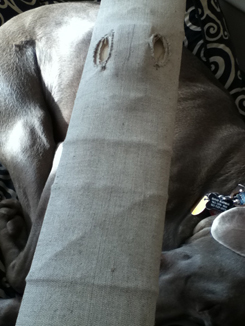
 Attachment: 94.03 KB Attachment: 94.03 KB
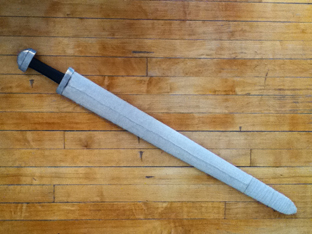
 Attachment: 89.04 KB Attachment: 89.04 KB
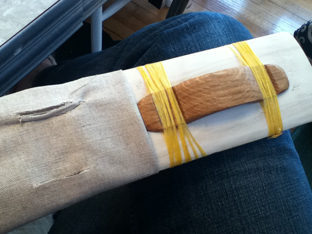
 Attachment: 83.1 KB Attachment: 83.1 KB
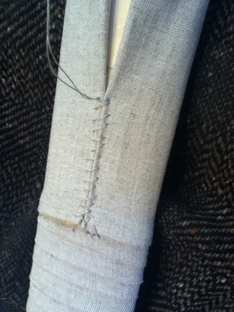
Tim Jorgensen
Midwest Viking Festival Coordinator
Hjemkomst Center
http://www.hcscconline.org/secondarypages/mid...tival.html
|
|
  |
 |
Johan Gemvik

|
 Posted: Sun 09 Jan, 2011 9:41 pm Post subject: Posted: Sun 09 Jan, 2011 9:41 pm Post subject: |
 |
|
Looks good. I especially like the third picture, could be taken right out of Geibigs drawing.
If we're following the "unnamed monks'" construction description of the Charlemagne scabbard then the linen should be clear waxed (melted hot onto the scabbard) to seal it. I expect this can shrink and tighten the linen but I haven't gotten to testing it myself yet.
About the hide glue, we discussed Casein glue which is water resistant. I'm going to saturate my cover with it and see if any further conditioning of the surface is needed.
To protect the wood under the scabbard slider where the opening in the fabric would expose it, you can probably add a patch of linen first, then the slider, then the linen wrap. Only surface exposed would be the slider which could be made in bone, antler, horn or metal instead of wood.
"The Dwarf sees farther than the Giant when he has the giant's shoulder to mount on" -Coleridge
|
|
  |
 |
Johan Gemvik

|
 Posted: Sun 09 Jan, 2011 9:57 pm Post subject: Posted: Sun 09 Jan, 2011 9:57 pm Post subject: |
 |
|
For an explanation of what Tim is doing, here's some background.
An interesting contemporary age quote from H. E. Davidsons book The sword in Anglo-saxon England:

Interesting contemporary age art, depicting Charlemagne and Pippin the hunchback, possibly of the very same scabbard.

One of Geibigs drawings of fabric wrapped scabbards.

Now if I can only convince my brother that his christmas gift sword scabbard needs another layer so I can add the linen wrap. Alas he does seem to much in love with the rustic leather look. 
"The Dwarf sees farther than the Giant when he has the giant's shoulder to mount on" -Coleridge
|
|
  |
 |
|
Tim Jorgensen
|
 Posted: Mon 10 Jan, 2011 5:39 am Post subject: Posted: Mon 10 Jan, 2011 5:39 am Post subject: |
 |
|
Thanks for the tips Johan. I forgot to mention that I tried various surface treatments on patches of linen yesterday, and the wax was extremely durable if it is applied hot enough to get into the fiber. I guess I'll have to study the kind of wax used during the period. We've got plenty of beeswax, if that's needed.
This cover is just sewn on for right now, so I will undo it to add more X-bracing toward the tip and some linen under the slider. I'll try an antler or bone slider as well and maybe save this oak one for the next project.
I'm looking forward to seeing what's going on over in Sverige!
Tim
Tim Jorgensen
Midwest Viking Festival Coordinator
Hjemkomst Center
http://www.hcscconline.org/secondarypages/mid...tival.html
|
|
  |
 |
Matt Lukes
Industry Professional

Location: Vancouver, Canada Joined: 26 Jun 2010
Posts: 7
|
 Posted: Tue 11 Jan, 2011 7:30 am Post subject: Posted: Tue 11 Jan, 2011 7:30 am Post subject: |
 |
|
You don't actually have to melt the wax onto the linen, nor is it likely the easiest method- rub it on and then warm it so the wax that's already partly forced into the fibres softens and either flows deeper or can be easily rubbed deeper with a bit of smooth wood or bone. Melted wax is hot and not a ton of fun to work with, especially when you're trying to coat something 
Ohhhh- pillage THEN burn...
|
|
   |
 |
|
Tim Jorgensen
|
 Posted: Wed 12 Jan, 2011 6:24 pm Post subject: Posted: Wed 12 Jan, 2011 6:24 pm Post subject: |
 |
|
Ok, I made some changes. I took off the linen and washed it, sewing it on while it was still a bit damp and stretchy, added another X-brace of cording, and added a waxed linen section under the slider. I applied hide glue to the seam and the X-braced sections, which was a bad idea in hindsight because it quickly becomes sticky from the oil of hands or any moisture.
So, in an extremely modern move, I coated the entire scabbard with water-based wood sealer and wiped off the hide glue once the sealer softened it up. See, quite the mess I'm making here. But it's fun, so I'll keep on.
Johan's research on waxed linen is the way to go. I applied some wax from white tea candles and rubbed it in a section using an oak block. It'll work well for the rest of the scabbard and that is how I will finish it after the sealer dries. Ok, maybe the wax is a little thick. Time for the heat gun.
So, here are some pictures from when the sealer was still damp.
Love, live, and learn, but focus on the love.
TJ
 Attachment: 100.34 KB Attachment: 100.34 KB
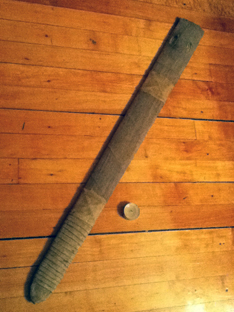
 Attachment: 100.5 KB Attachment: 100.5 KB
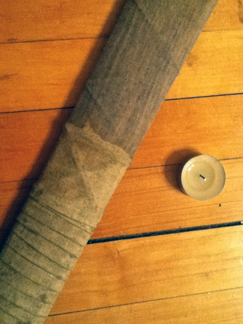
 Attachment: 89.25 KB Attachment: 89.25 KB
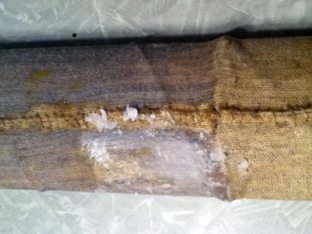
Tim Jorgensen
Midwest Viking Festival Coordinator
Hjemkomst Center
http://www.hcscconline.org/secondarypages/mid...tival.html
|
|
  |
 |
Artis Aboltins

|
 Posted: Wed 12 Jan, 2011 10:35 pm Post subject: Posted: Wed 12 Jan, 2011 10:35 pm Post subject: |
 |
|
|
Mhm, Tim, you sure that the stuff in those wite candles is wax? At least here, it is usually some mix of stearin, not beewax... and If it is not a mix containing high amount of beewax, it might not be a good idea to have it on your linen. otherwise, great work, can't wait to see the more project pictures!
|
|
  |
 |
|
Tim Jorgensen
|
 Posted: Thu 13 Jan, 2011 5:39 am Post subject: Posted: Thu 13 Jan, 2011 5:39 am Post subject: |
 |
|
| Artis Aboltins wrote: | | Mhm, Tim, you sure that the stuff in those wite candles is wax? At least here, it is usually some mix of stearin, not beewax... and If it is not a mix containing high amount of beewax, it might not be a good idea to have it on your linen. otherwise, great work, can't wait to see the more project pictures! |
Oh, yup, you're right about that. I've got some beeswax here, so I'll give that a try. Thanks for the tip!
Tim Jorgensen
Midwest Viking Festival Coordinator
Hjemkomst Center
http://www.hcscconline.org/secondarypages/mid...tival.html
|
|
  |
 |
|
Richard Hare
Location: Alberta, canada Joined: 15 Mar 2008
Posts: 135
|
 Posted: Thu 13 Jan, 2011 6:06 am Post subject: Posted: Thu 13 Jan, 2011 6:06 am Post subject: |
 |
|
Nice to see your work, Tim!
It is looking very neat.
I think the binding can also go over the top of the linen, But that is just an option, and both ways are I'm sure "right"!
Very nice to see scabbards of this type. Thank you for posting.
Richard.
|
|
   |
 |
|
Tim Jorgensen
|
 Posted: Thu 13 Jan, 2011 7:20 am Post subject: Posted: Thu 13 Jan, 2011 7:20 am Post subject: |
 |
|
Another advisory sent me a note to try any one of the following linseed oil treatments:
The earliest known varnish recip...e is from Theophilus. I make it using ground Dominican amber for what he calls "fornis" and it makes a gorgeous finish.
The Gluten [Called] Varnish
Put some linseed oil into a small new pot and add some very finely ground resin, which is called fornis, and which looks like very clear frankincense except that when it is broken up it has a higher luster. After putting it on the fire, cook it carefully, without letting it boil, until a third of it has evaporated. Beware of flame, because the varnish is extremely dangerous and, if it should catch fire, difficult to extinguish. Every painting that is coated with this gluten is made bright, beautiful, and completely lasting.
Another method.
Set up four stones which can withstand fire without spalling, and place a raw pot upon them. In the pot put some of the afore-mentioned resin, fornis, which is called glassa in Roman. Over the mouth of this pot place a smaller one with a little hole in the bottom. Smear some paste around it so that no air can escape between the two pots. Then build a fire carefully beneath it until the resin melts. You should also have a thin iron rod fitted into a handle, with which you can stir the resin and feel when it becomes completely liquid. You should also have a third pot on the fire close by, with hot linseed oil in it. When the resin is thoroughly liquid so that, when you take out the iron rod, a sort of thread is trailed behind it, pour the hot oil into it, stir with the rod, and cook them together without letting them boil. Occasionally take out the rod and smear a little on a piece of wood or stone to test its consistency. Take care that there are two parts of oil and a third part of resin by weight. When you have cooked it carefully to your satisfaction, take it off the fire, uncover it, and let it cool.
How To Redden Doors; and Linseed Oil
If you want to redden doors, get linseed oil which you should make in this way. Take some flax seed and dry it in a pan over the fire without water. Then put it in a mortar and pound it with a pestle until it becomes a very fine powder. Put it back in the pan, pour in a little water, and heat it strongly. Afterwards wrap it in a new cloth and put it on the press where oil is usually pressed from olives, nuts and poppy seeds, and press out this oil also in the same way. Grind some minium (red lead, Pb3O4) or cinnabar with this oil on a stone without water, spread it with a brush on the doors or panels that you want to redden and dry them in the sun. Then coat them a second time and dry them again. Finally spread on top if it the gluten called varnish...
Tim Jorgensen
Midwest Viking Festival Coordinator
Hjemkomst Center
http://www.hcscconline.org/secondarypages/mid...tival.html
|
|
  |
 |
Johan Gemvik

|
 Posted: Thu 13 Jan, 2011 10:31 am Post subject: Posted: Thu 13 Jan, 2011 10:31 am Post subject: |
 |
|
Wood sealer may be modern but very similar in result to casein glue.
Stearin is also modern but perhaps close enough to wax to be comparable in end result. I've used stearin and stearin/beeswax combinations to good effect on leather. It gives more of a lustre to the surface when polished and is stiffer, but I don't think that'll matter on a scabbard.
A real craftsman uses what's at hand, I'm sure much we see preserved today is based on that same principle.
I've just made a batch of casein glue on the stove to test on my wrapping and have a big chunk of bees wax for the coating. I see this project of ours as a learning experience for both of us and as always it's the road traveled as much as the end result that counts. But I still think the scabbard of yours is turning out beautifully. I'm impressed! Has the "student" surpassed the "master"? We shall see... 
"The Dwarf sees farther than the Giant when he has the giant's shoulder to mount on" -Coleridge
|
|
  |
 |
Johan Gemvik

|
 Posted: Thu 13 Jan, 2011 10:36 am Post subject: Posted: Thu 13 Jan, 2011 10:36 am Post subject: |
 |
|
By the way, Tim isn't one to brag, but this is his first scabbard and just look at it! As I said, I'm impressed.
"The Dwarf sees farther than the Giant when he has the giant's shoulder to mount on" -Coleridge
|
|
  |
 |
|
Tim Jorgensen
|
 Posted: Mon 17 Jan, 2011 8:02 pm Post subject: Posted: Mon 17 Jan, 2011 8:02 pm Post subject: |
 |
|
Ok, tonight was the beeswax party experiment. I put 1 part linseed oil with 3 parts beeswax in a double boiler (glass jar in hot water on the stove) and stirred it on low heat until it was all liquid. I used a brush with animal hair bristles, so it wouldn't melt in the hot wax.
The wax brushed on easily and began to solidify so quickly that I could only make short single sweeps. That was plenty since it dried rather thick, but at least it went on uniformly. Then, after experimenting with a lighter to melt and rub off the excess, I decided to try a heat gun and work my way from the tip on up, occasionally tapping the scabbard on a resting block so that any melted excess would drip off. One of the photos shows the hot wax oozing from the surface.
The color changes spooked me at first when I started at the tip. The photo shows blotches that appeared with the use of the heat gun. Maybe that's where the oil or wax permeated to a deeper level, I'm not sure. The lighter, more natural color of linen that one might expect to see is most visible at the tip, where the overlapping layers prevented the wood from showing through the oiled linen. Geibig's illustrations show an overlapping flap at various points on the scabbard other than just the tip, and it is my guess that these overlaps appeared as rings or bands around the scabbard for those who drew depictions of Charlemagne and others with linen scabbard.
Overall I thought it went well, but the linseed oil is still going to need some time to dry out. It is all very waterproof now, so that's progress, and it smells like honey, so I guess that's period-accurate.
Does the Tinker Viking sword work well with this? I'm not sure. Maybe a Tinker Norman is in order.
In other scabbard news, my birch arrived today. So scabbard #2 is in the works.
Thanks Johan. I don't brag much, but my turkey stuffing at Thanksgiving was pretty good last year.
 Attachment: 91.24 KB Attachment: 91.24 KB
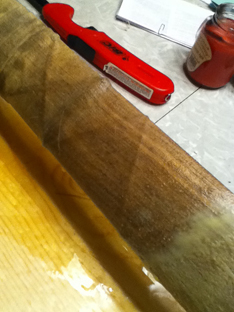
 Attachment: 87.92 KB Attachment: 87.92 KB
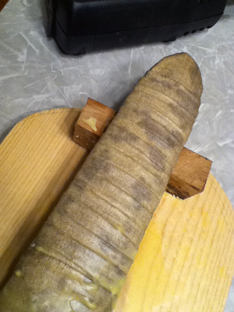
Tim Jorgensen
Midwest Viking Festival Coordinator
Hjemkomst Center
http://www.hcscconline.org/secondarypages/mid...tival.html
|
|
  |
 |
|
Tim Jorgensen
|
 Posted: Sun 30 Jan, 2011 6:54 pm Post subject: Latvia 10th C VIking Sword - Linen & Leather scabbard Posted: Sun 30 Jan, 2011 6:54 pm Post subject: Latvia 10th C VIking Sword - Linen & Leather scabbard |
 |
|
I dropped by eBay to see what "Viking" swords were showing up lately, and this "Xth C. Ancient Viking Sword" showed up from a seller in Latvia. Regardless of the accuracy of the claim, it's nice to see an old one with the leather on top of the cloth for the scabbard construction.
 Attachment: 131.78 KB Attachment: 131.78 KB
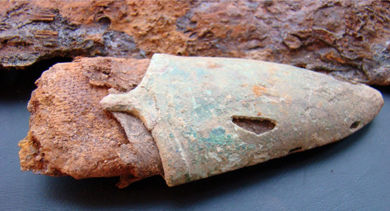
 Attachment: 109.32 KB Attachment: 109.32 KB
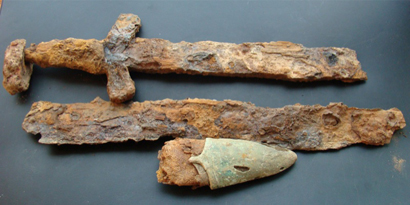
Tim Jorgensen
Midwest Viking Festival Coordinator
Hjemkomst Center
http://www.hcscconline.org/secondarypages/mid...tival.html
|
|
  |
 |
Arunas Bugvilionis
Industry Professional

Location: Lithuania, Baltic tribes, Vilkatlakai Joined: 24 Jan 2011
Posts: 41
|
 Posted: Sun 30 Jan, 2011 11:52 pm Post subject: Posted: Sun 30 Jan, 2011 11:52 pm Post subject: |
 |
|
Yes,in Latvia in some Lyvian burrials was founded bronze scabbard bindings with the scabard remains.So there is such combination: wood, linnen, leather; wood, linnen; in Lithuania is some findings: wood, linnen thread. Laboratory's analysis displayed that offten outer layer of the scabard was covered with wax,a bee wax of course 
So don't stop, You work well.
Proud to be where I was born !
|
|
   |
 |
Artis Aboltins

|
 Posted: Mon 31 Jan, 2011 2:06 am Post subject: Posted: Mon 31 Jan, 2011 2:06 am Post subject: |
 |
|
Nice picture, only sad thing that it is 99% sure attained by grave-robbing  since our government has very little experience with dealing with metal-detector using enthusiasts, some less-scrupulous of them are running wild and digging up everything they can find, and it is not possible to place a policeman on permanent station near every known burial site or hillfort. The fact that in most cases official science considers everyone of those enthusiasts to be a grave-robbers does not help either so we can only hope it will eventually grow into some form of mutually beneficial coexistence as it is elsewhere in the world (Straffordshire hoard find comes to mind as positive example of such coexistence). since our government has very little experience with dealing with metal-detector using enthusiasts, some less-scrupulous of them are running wild and digging up everything they can find, and it is not possible to place a policeman on permanent station near every known burial site or hillfort. The fact that in most cases official science considers everyone of those enthusiasts to be a grave-robbers does not help either so we can only hope it will eventually grow into some form of mutually beneficial coexistence as it is elsewhere in the world (Straffordshire hoard find comes to mind as positive example of such coexistence).
|
|
  |
 |
|
William P
|
 Posted: Tue 17 Jan, 2012 6:15 am Post subject: Posted: Tue 17 Jan, 2012 6:15 am Post subject: |
 |
|
|
so just so im clear, what periods are these linen scabbards dated to, and what cultures,
|
|
   |
 |
|
Tim Jorgensen
|
|
  |
 |
|
William P
|
 Posted: Tue 17 Jan, 2012 10:44 pm Post subject: Posted: Tue 17 Jan, 2012 10:44 pm Post subject: |
 |
|
so if im not mistaken, purely linen covered scabards seem to mostly be 9th century, and less prevelant towardsthe 10th and 11th centuries?
|
|
   |
 |
|
Tim Jorgensen
|
 Posted: Wed 18 Jan, 2012 5:17 am Post subject: Posted: Wed 18 Jan, 2012 5:17 am Post subject: |
 |
|
You're probably right about that, William. Research is rather limited with these from what I can tell. I thought it would be worth a try to make one, so I did. It's much stronger than I'd expected. I still wonder about the X-bracing as to if it served both as symbolic (the crosses representing the destruction of the heathens) and as structural support. I also am not sure if the x-bracing strips would be under or over the main linen covering, but I think under makes the most sense.
Some people tell me I should paint or dye the linen to make it colorful like the ones you see in illustrations of Charlemagne, but I prefer the common and ordinary, for the most part.
If you are delving into further research on linen scabbards, please keep us informed. I know Johan Gemvik over in Sweden is also curious.
I'll be heading to York next month. Maybe there'll be some more info there. I'll post anything worth reading/seeing.
Tim
|
|
  |
 |
|
|
You cannot post new topics in this forum
You cannot reply to topics in this forum
You cannot edit your posts in this forum
You cannot delete your posts in this forum
You cannot vote in polls in this forum
You cannot attach files in this forum
You can download files in this forum
|
All contents © Copyright 2003-2025 myArmoury.com — All rights reserved
Discussion forums powered by phpBB © The phpBB Group
Switch to the Basic Low-bandwidth Version of the forum
|

